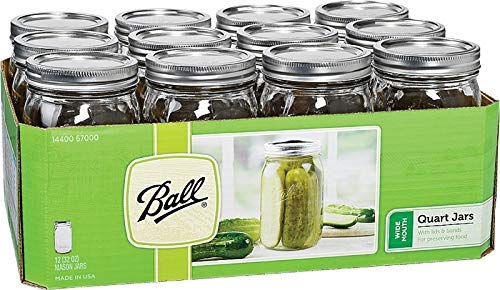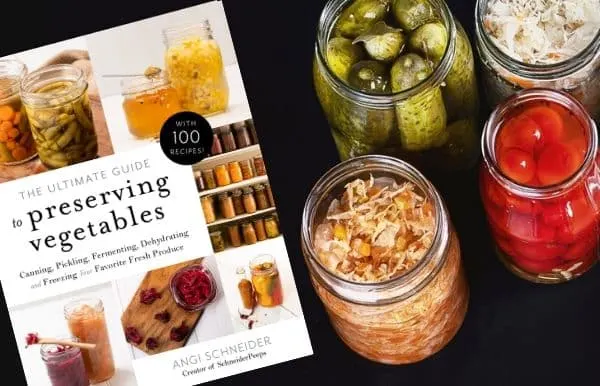Fermented peppers easy to make and are fantastic for someone just beginning the fermenting journey.

Sauerkraut. Isn’t that where everyone begins with fermented vegetables? I think it must be as there are many, many sauerkraut articles all over the place
I think one of the reasons sauerkraut is such a great place to begin is because it’s easy and it tastes great. At least I think it tastes great. However, my “vinegar hating” husband doesn’t quite get how wonderful it is. {sigh}

I know that if I’m going to win my family over on this fermenting thing that it’s going to be a little at a time and that I’m going to have to start with things they already love. So, in addition to sauerkraut. I’ve been fermenting peppers.
And guess what? They love them! The fermented peppers don’t have a vinegar taste that pickled peppers do and the fermenting seems to make the pepper a little spicier.
While making sauerkraut is easy, fermenting peppers is super easy. All you need is peppers, salt, water and something to ferment them in. I’m using a wide mouth pint size jar and either Fermentools lids or Easy Fermenter lids.
One thing I really like about mason jars for fermenting is that I can try different ferments in small batches until I find out what my family really likes.

To make fermented peppers just slice your peppers in rings or long slices, the shape doesn’t matter. Also, if you are fermenting small peppers you can just leave them whole if you want.
Make enough 2% brine to cover the peppers. This can get tricky and you can do math and weigh your salt and your water to get a 2% brine. Or you can do what I do and just “estimate”.
The idea is to have enough salt to inhibit mold growing but not so much that it halts the fermentation process. I’ve found that using 1 Tbsp of salt (I usually use fine sea salt or Himalayan salt) to 1 quart of non-chlorinated water works just fine.
To calculate a 2% salt brine for fermenting you’ll need a digital scale and a calculator.
- Put a quart size jar on the scale and set it to zero. You’ll want to measure in grams so set the units to grams.
- Fill the jar with water (stopping about an inch from the rim).
- Make a note of the weight (it should be 850-950 grams depending on how full you filled the glass)
- Grab a calculator and multiply the weight of the water by .02 and add that number to the weight of the water (this will be the total weight of the brine after the salt is added)
- Add enough salt to reach this number.
Put the peppers in your jar and pour the brine over them. Make sure you have some kind of weight to keep the peppers under the brine as they tend to float. If any of the seeds float above the weight, just skim them off. Add lid and let the peppers ferment in a cool dark place for 5-10 days.
Check your peppers every day or so. The fermenting process is more of an art than a science and there are many variables that will cause your peppers to ferment in just a couple of days or take up to two weeks.
When the peppers are fermented to your liking, remove the fermenting lid and weight. Replace the fermenting lid with a storage lid and store in the refrigerator.

The process is the same if you are fermenting jalapeno peppers or sweet banana peppers. We like to mix the spicy peppers in a jar, so we usually have jalapeno, poblano, and cayenne peppers all mixed in the same jar.
I don’t care much for hot peppers but I love pickled banana peppers so we ferment the banana peppers all by themselves. We also will usually add a garlic clove or two to the mix.
I have a set of worksheets I print each year to keep track of what I’ve preserved. You can get the worksheets emailed to you by filling out the form below.
Fermented Peppers

You can use this process to ferment any pepper - both sweet and hot. Why make vinegar pickled peppers when fermented peppers are easier and much better for your gut health.
Ingredients
- peppers to fill a wide mouth pint mason jar - jalapenos, poblano, cayenne, banana, even bell peppers.
- 1-2 cloves garlic (optional)
- 1 tbsp non-iodized salt
- 1 quart non-chlorinated water
- wide mouth pint mason jar
- fermenting lid
Instructions
- Make a brine using 1 Tbsp non-iodized salt and 1 quart non-chlorinated water. Set aside
- Slice peppers (you can cut in rings or lengthwise whatever you like best)
- Remove seeds if you want to (we don't do this but it seems to be a common practice to remove peppers seeds)
- Pack peppers into wide mouth pint size mason jar
- Put the peel garlic cloves into the jar if you are using garlic
- Pour brine over peppers in jar
- Put a glass weight on top of the peppers to submerge them. Try to remove any seeds that float up above the weight
- Add fermenting lid to jar
- Store in a cool, dark place for 5-10 days. Check your peppers every day or so. The fermenting process is more of an art than a science and there are many variables that will cause your peppers to ferment in just a couple of days or take up to two weeks.
- Once the peppers are sufficiently fermented, remove the fermenting lid and weight.
- Cover the jar with a plastic storage lid and store in the refrigerator.
Recommended Products
As an Amazon Associate and member of other affiliate programs, I earn from qualifying purchases.
-
 Easy Fermenter Wide Mouth Lid Kit: Simplified Fermenting In Jars Not Crock Pots! Make Sauerkraut, Kimchi, Pickles Or Any Fermented Probiotic Foods. 3 Lids(jars not incld), Extractor Pump & Recipes
Easy Fermenter Wide Mouth Lid Kit: Simplified Fermenting In Jars Not Crock Pots! Make Sauerkraut, Kimchi, Pickles Or Any Fermented Probiotic Foods. 3 Lids(jars not incld), Extractor Pump & Recipes -
 Ball Mason 32 oz Wide Mouth Jars with Lids and Bands, Set of 12 Jars.
Ball Mason 32 oz Wide Mouth Jars with Lids and Bands, Set of 12 Jars. -
 Redmond Real Salt - Ancient Fine Sea Salt, Unrefined Mineral Salt, 16 Ounce Pouch (2 Pack)
Redmond Real Salt - Ancient Fine Sea Salt, Unrefined Mineral Salt, 16 Ounce Pouch (2 Pack)
Here are some other ways to ferment peppers that you might enjoy…
How to Make Fermented Hot Sauce from Grow Forage Cook Ferment
The BEST Fire Roasted Jalapeno Fermented Hot Sauce Recipe from Homestead Honey
Fermented Pepperoncini Hot Sauce from Grow Forage Cook Ferment
Lacto-fermented Hot Sauce from Joybilee Farm
Banana Pepper Recipe: Fermented Hot Sauce from Attainable-Sustainable
Lacto-fermented Hot Sauce with Nasturtiums from Nitty Gritty Life
The Herbal Academy has a fantastic fermentation course available. You can learn how to make mead, herbal beer and wine, water kefir, and fermented foods.

The Ultimate Guide to Preserving Vegetables
If you you’re looking for more preserving inspiration, I know you’ll love The Ultimate Guide to Preserving Vegetables. In this book I share how to can, dehydrate, freeze and ferment almost every vegetable. I also share 100 favorite recipes for preserving the vegetables in fun way that will save you time and money later. Get your copy here. Get your copy here.

What have you been fermenting lately?

Judy
Monday 23rd of August 2021
I really want to learn how to ferment foods (vegetables) for the gut health benefits. I have high blood pressure so I try to be careful of my salt intake. Is there a fermentation process that is low sodium? Can it be done without salt?
Angi Schneider
Friday 27th of August 2021
There are lots of different ferments and some do not use salt. You might find this article from Joybilee Farms helpful.
Ruth Schwartz
Monday 19th of July 2021
It looks like you never use a water bath to finish your fermented vegetables. Aren’t you afraid of bacteria?
Angi Schneider
Monday 19th of July 2021
There are good and bad bacteria, when done properly fermented vegetables are full of good bacteria. That bacteria would be destroyed if finished by canning. Instead I store my fermented vegetables in the refrigerator. As long as the vegetables stay under the brine, there is no risk of mold or bad bacteria growing. The environment of the brine is very acidic and botulism cannot grow in an acidic environment. Fermentation is one of the oldest forms of preserving food, along with dehydrating, and has been safely done for thousands of years before canning was invented.
Phil
Friday 14th of May 2021
Thank you for the nice article! Funny -- just like you said, I started with plain sauerkraut, started adding spices, and now I'm looking forward to trying all sorts of veggies. Hot peppers sound great. Cheers!
Vanessa
Monday 15th of February 2021
Thanks for sharing! Do they keep long?
Angi Schneider
Thursday 18th of February 2021
A year or so in the refrigerator.
Suzanne
Monday 15th of February 2021
This looks so good! What a great way to get some more fermented foods in your diet and preserve your garden peppers!